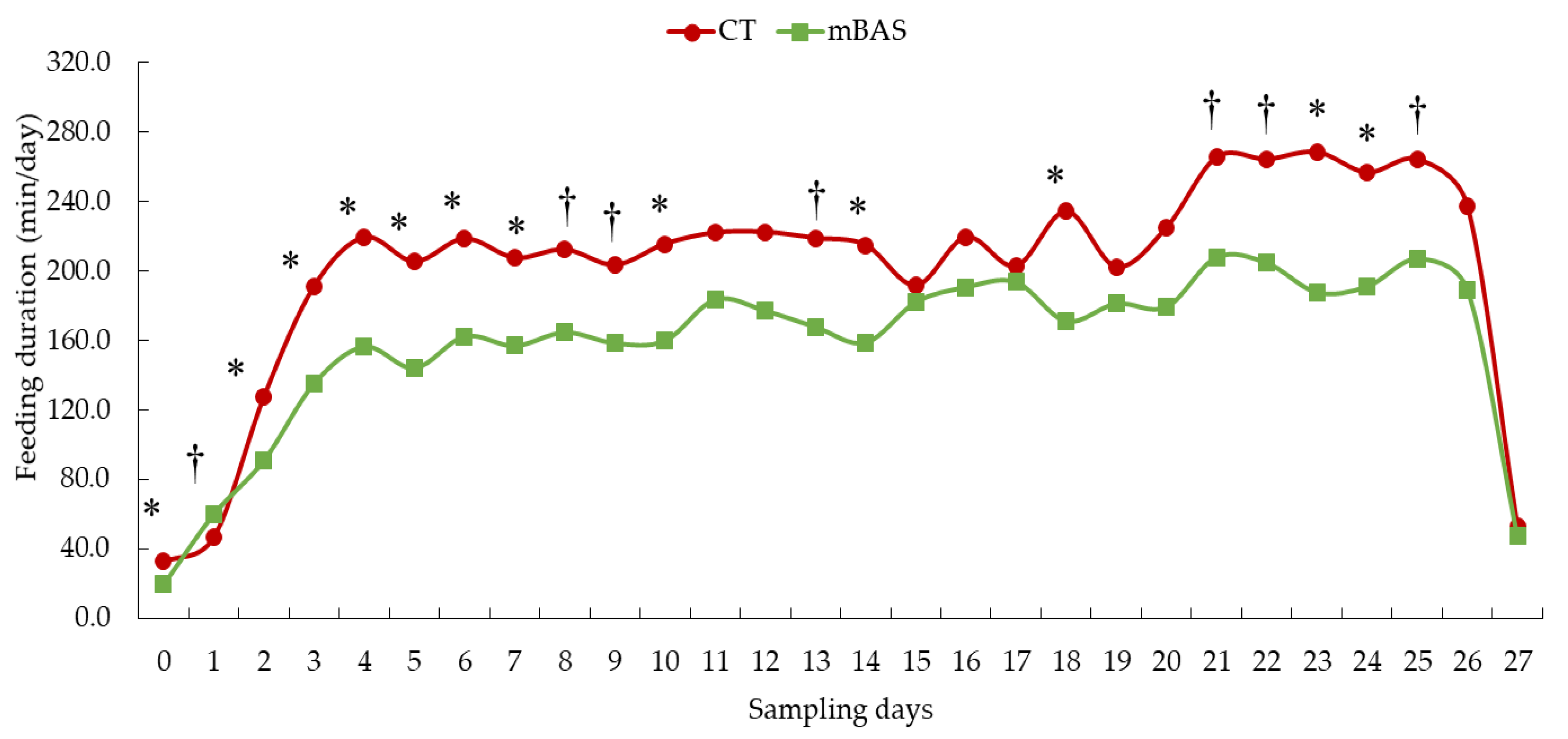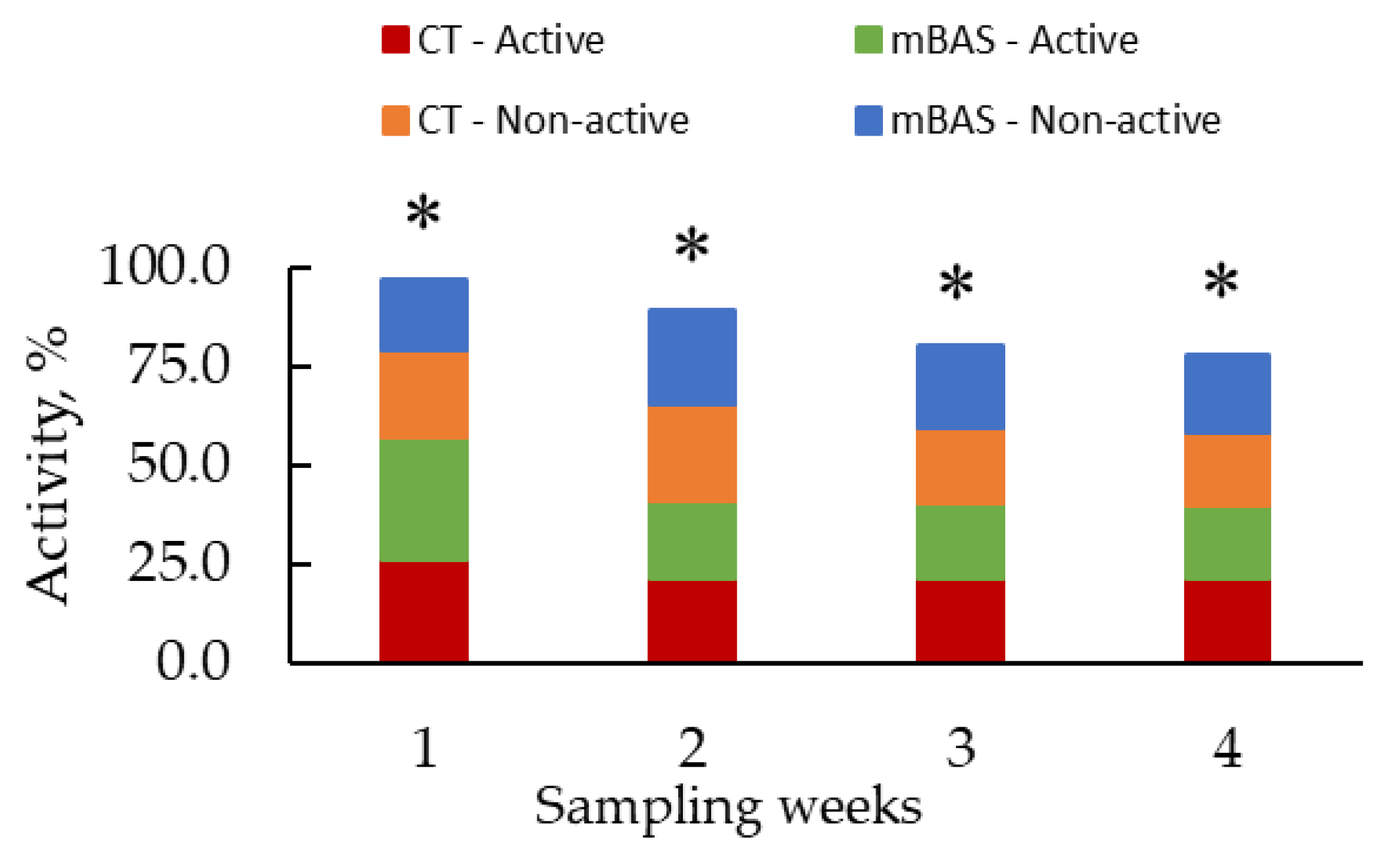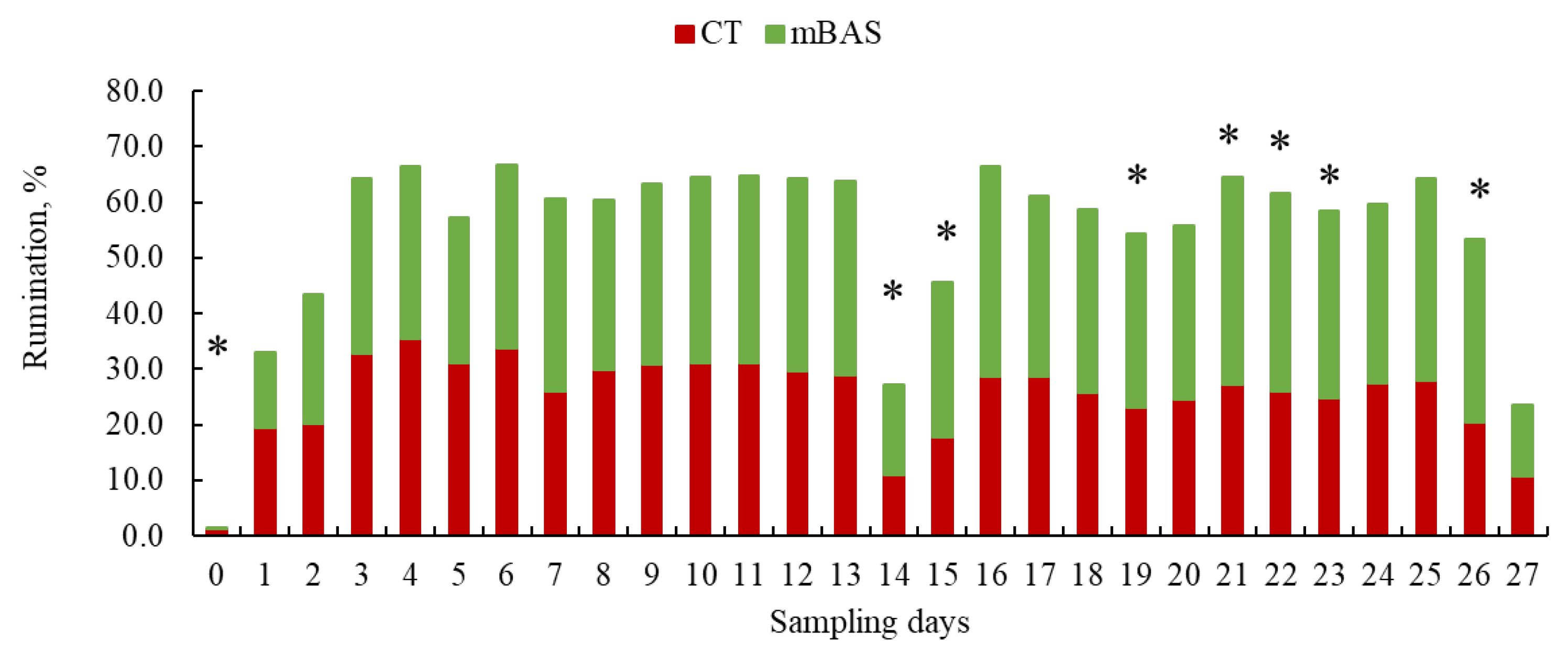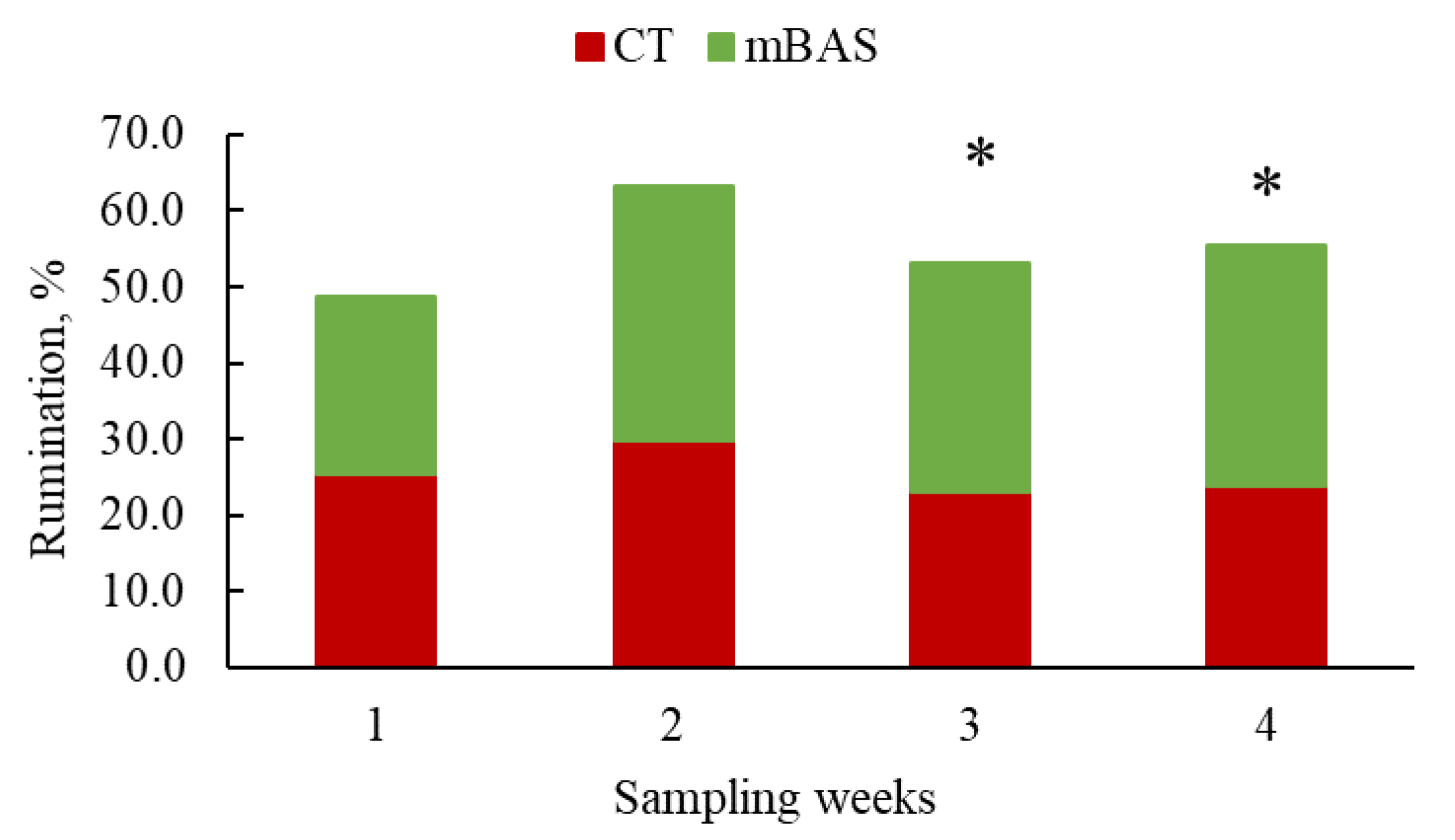1. Introduction
In the North American beef industry, weaning calves from their mothers, typically between 6 and 8 months of age [
1], marks a profoundly stressful transition due to the loss of both maternal presence and milk [
2,
3]. This initial stress is often intensified by a cascade of other challenges calves encounter around weaning or upon feedlot entry. These can include processing procedures such as ear tagging, vaccination, and growth implants, as well as stress from transportation and auction markets [
1]. Over their first days in the feedlot, calves must also adapt to entirely new feed sources and establish new social structures, leading to competition [
4]. The cumulative effect of these stressors significantly compromises their immune systems, leaving them highly vulnerable to Bovine Respiratory Disease (BRD), which is the primary driver of morbidity, mortality, and substantial economic losses within the industry [
5,
6]. To cope with these stressors, calves employ subtle behavioral and physiological adaptations, including altered feeding patterns [
2] and immune system activation [
3,
7], aiming to facilitate their adjustment to the new environment.
Management strategies such as preconditioning, which involves practices like vaccinating calves at least 30–60 days before weaning [
8], as well as castrating and dehorning at least three weeks prior to transport, and acclimating them to feed bunks, are known to reduce stress and improve calf health and welfare [
1,
9]. However, the implementation of preconditioning programs across North America has been inconsistent, largely due to concerns about their cost-effectiveness for both cow–calf and feedlot producers [
1,
8,
10,
11]. In Canada, preconditioned calves typically do not receive price premiums, further limiting uptake [
1]. As a result, there is a critical need for effective, low-cost strategies that can mitigate stress, support adaptation to the feedlot environment, and enhance the overall welfare of newly weaned calves.
All mammals, including bovine species, possess an evolutionarily conserved mechanism in which maternal appeasing substances (mBAS), a complex blend of volatile and non-volatile compounds such as fatty acids [
12,
13], are released by specialized sebaceous glands, primarily around the mammary and inguinal regions [
14]. These pheromone-like substances play a vital role in establishing cow–calf bonding and promoting behavioral and physiological stability in offspring during stressful events [
13]. Multiple studies conducted in the U.S. have demonstrated promising results with synthetic mBAS in beef cattle, a compound that replicates the natural pheromone. When administered at weaning or feedlot entry, improvement on growth performance [
15,
16,
17,
18,
19] and immune responses [
18,
19,
20] were observed while enhancing feed efficiency [
17,
19], increasing feed intake [
17,
18] and reducing physiological stress responses [
15,
17,
18,
19,
20]. However, the effects on feed intake and feed efficiency remain inconclusive in the literature [
17,
18,
19,
20], possibly due to the fact that those previous studies have primarily relied on pen-level average feed intake and/or growth rates, which may mask individual variations. Thus, further studies are needed to evaluate the impact of mBAS on individual-level feed intake, growth, and feed efficiency, along with physiological and behavioral metrics of stress and health that may influence these outcomes in a feedlot setting.
The objective of this study was to evaluate the effects of a synthetic mBAS administration, that has been demonstrated to be effective for up to 15 days [
20], at weaning on the behavioral and physiological adaptation of beef heifers during the 28-day feedlot receiving period following transportation, as well as its impact on return-on-investment (ROI). We hypothesized that heifers treated with mBAS would exhibit reduced stress responses, improved feedlot adaptation, and enhanced performance outcomes compared to control heifers, ultimately resulting in a greater ROI.
4. Discussion
Weaning is one of the most stressful events in a beef calf’s life, with important consequences for health, welfare, and subsequent growth [
2]. During this event, calves face multiple concurrent stressors that can impair immunity, reduce feed intake, and hinder growth [
1,
2,
7], with the severity of responses varying according to individual stress resilience [
36,
37]. This study evaluated whether a single pre-transport administration of 10 mL mBAS at weaning could reduce transport-induced weight loss and improve feedlot adaptation in Angus-influenced heifers. Although mBAS had positive effects on certain indicators of health, stress, and growth, the overall outcomes did not fully meet initial expectations.
As anticipated from the study design, no differences in initial body weight were observed between treatment groups. However, a delayed positive effect of mBAS emerged, with treated heifers demonstrating superior growth performance during the third- and fourth-weeks post-weaning (Final BW, ADG
14–27, and ADG
0–27) compared to their water-treated counterparts. In summary, by the end of the 28-day trial, mBAS-treated heifers were 3.4% heavier (+12.3 kg) than controls. They also exhibited a 57.1% greater daily gain in weeks three and four (+800 g/day) and a 27.8% higher overall ADG (+500 g/day). These results are partially consistent with previous findings where mBAS was administered prior to loading or at feedlot entry. In Nellore bulls, weight gains were observed during the adaptation period (up to 19 days) when mBAS was applied at either time point [
17]. However, these advantages were not sustained through 60 days of the feeding period, and overall improvements up to day 108 were only maintained when mBAS was administered prior to loading [
17]. Likewise
Bos taurus ×
Bos indicus calves showed improved growth rates up to 28 days when mBAS was administered at weaning [
18]. However, these benefits were not sustained beyond this period, with no effects detected by day 42 [
18]. Other studies applying mBAS at feedlot entry have also yielded contradictory findings. Picket et al. [
20] found no effects on growth performance up to 60 days, whereas Colombo et al. [
19] reported no effects on body weight at days 7, 17, 31, or 45 but did observe overall weight gain across the entire feeding period. These discrepancies between the current and previous studies [
17,
18,
19,
20] remain unclear but suggest that the efficacy of mBAS may be context-dependent, influenced by factors such as time of administration, study length, or breed-specific stress responses, and warrant further investigation.
Notably, the enhanced growth observed in the current study was not driven by differences in dry matter intake. Overall, both groups consumed similar amounts of feed, averaging approximately 7.0 kg/head/day, consistent with previous findings for feedlot cattle during the first four weeks post-weaning [
38]. Instead, the improved performance likely reflects greater feed efficiency across the entire trial period, but particularly evident during the latter half of the study. These findings align with those reported by Colombo et al. [
19] who found a greater gain-to-feed ratio over a 45-day period in Angus-influenced calves treated with mBAS at feedlot entry compared with untreated controls. On the other hand, Schubach et al. [
18] reported no effects on feed efficiency over 42 days in
Bos taurus ×
Bos indicus calves when mBAS was applied at weaning. In contrast to the current study, Fonseca et al. [
17] reported a greater gain-to-feed ratio during the 19-day adaptation period in Nellore bulls when mBAS was administered at either prior to loading or feedlot entry, but long-term improvements over the 108-day feeding period were evident only when administered prior to loading.
The enhanced efficiency observed in the current study may have resulted from mBAS-mediated attenuation of stress-induced activation of the hypothalamic–pituitary–adrenal (HPA) axis, reducing secretion of adrenocorticotropic hormone (ACTH) and cortisol [
39,
40]. By diminishing the physiological stress response, mBAS likely reduces the metabolic costs of stress, supporting more efficient nutrient utilization and contributing to the growth advantage observed. Other mechanisms may also contribute, including potential effects on nutrient digestibility, rumen function [
41], behavioral circadian rhythms [
42], or even factors related to experimental conditions. The previously cited studies used larger groups (>40 animals per treatment), exposing cattle to greater disease and social stress. By contrast, the smaller groups in the present study likely reduced stress, contributing to improved feed efficiency. Therefore, the outcomes observed in this study should be interpreted with caution, as they may not fully reflect the conditions or results expected in typical commercial feedlot environments.
Given the lack of effects on shrunk body weight and percentage of body weight loss (both groups lost 1.4% of BW), two possible explanations can be considered: (1) although transport conditions were carefully standardized between groups, potential confounding factors such as interior ventilation, vibration frequency, noise, and light levels, could have influenced the outcomes and; (2) the transportation conditions in this trial may not have been sufficient to elicit a measurable stress response capable of triggering acute metabolic losses. Heifers were transported approximately 84 km (1 h), and all handling procedures, including loading, transport, unloading, resting, and post-transport weighing and sampling, were conducted calmly by experienced handlers who were familiar to the animals. The entire process was completed within about three hours per group.
Previous research has shown that salivary cortisol concentrations in calves rise within 20 min following artificial ACTH stimulation (as a proxy of stress response) and typically return to baseline in approximately three hours [
43]. Since our sampling period fell within this expected window, we initially hypothesized that treatment differences in cortisol would be detectable. However, it is possible that a transient cortisol peak occurred outside the specific sampling points, or alternatively, that the relatively mild transport and handling conditions limited HPA axis activation to levels undetectable in salivary samples. Cortisol, a key stress hormone released via HPA axis activation, supports short-term adaptation by mobilizing energy through gluconeogenesis [
13,
39,
44]. However, prolonged elevation can suppress immunity, reduce growth, and compromise animal health and performance [
39,
44]. Our findings in salivary cortisol align with previous studies [
15,
17] reporting no differences in serum (or plasma) cortisol concentrations between cattle that received or not a single treatment of mBAS prior to loading or at weaning. The lack of physiological differences was consistent with the absence of behavioral differences at handling, as assessed through chute score and exit speed. In contrast, stress-mitigating effects of mBAS have been reported in other contexts. Colombo et al. [
19] observed reduced plasma cortisol on days 7 and 17 relative to feedlot arrival, but not on days 31 or 45. Schubach et al. [
18], found no effects of mBAS on plasma cortisol over 42 days; however, they reported a tendency for lower exit speed by day 7, a significant exit speed reduction by day 14, and decreased hair cortisol concentrations also on day 14. Unlike serum, plasma, or salivary cortisol, which reflects acute fluctuations, hair cortisol represents cumulative HPA axis activity over time [
45]. Taken together, these findings suggest that the effects of mBAS on cortisol measures are most evident during the early phase of feedlot adaptation, consistent with its effectiveness for approximately two weeks post-application, with no sustained benefits observed beyond this period.
Although mBAS heifers demonstrated indications of greater dry matter intake than controls on days 6, 15, 17, and 19 of the 28-day period, the absence of consistent overall differences aligns with previous research, where mBAS administration prior to loading or at feedlot entry in
Bos indicus or
Bos taurus cattle produced inconsistent or negligible effects on intake when evaluated at the pen level [
17,
18,
19,
20]. These inconsistencies may be attributed to differences in social dynamics, metabolic regulation, or breed-specific temperament. In addition, variation in feed intake measurement methodology, especially between individual- versus pen-level data, may further contribute to uneven outcomes. To the best of our knowledge, this is the first study to evaluate mBAS effects using individual feed intake data from feedlot cattle in North America, allowing for a more precise assessment of feeding behavior.
Interestingly, during the first two weeks, treated heifers spent less time at the feed bunk but consumed feed at a faster rate during week 1, despite only slight differences between treatments in bunk visits. This feeding pattern mirrors findings by Proudfoot et al. [
46], who reported that multiparous dairy cows in competitive environments, such as the initial feeding period, increased their eating rate to maintain intake while reducing time at the bunk. Similarly, mBAS-treated heifers appeared to adopt a feeding strategy characterized by shorter, more purposeful bouts at the bunk, thereby limiting energy expenditure and competition while supporting recovery and adjustment to the feedlot environment. A previous study also reported that mBAS-treated calves spent more time in physical activity such as engaging in social behaviors (e.g., mounting) compared with untreated calves, particularly during the first two days in the feedlot, a behavior associated not only with reproductive activity but also with the establishment of social hierarchy [
18].
The initial increase in activity may be attributed to either (1) stress associated with maternal separation or (2) exploratory motivation to interact with novel elements of the environment, such as the feed bunk [
18,
47]. In contrast, the subsequent decline may indicates calmer behavior, as also reported by Schubach et al. [
18]. In their study, mBAS treated calves tended to display more allogrooming and exhibited increased physical activity on day 1 compared with controls, but no differences were observed on subsequent days (up to day 41). Although the mechanisms remain unclear, this shift observed in the current study likely reflects reduced stress reactivity and more effective allocation of energy toward nutrient utilization, ultimately contributing to improved feed efficiency [
48]. Given the known 15-day efficacy of mBAS [
18], these findings suggest that the product may help calves transition more smoothly during the critical early adaptation period by modulating feeding dynamics and behavioral responses [
17,
18].
Consistent with this, mBAS-treated heifers ruminated more during the third- and fourth-weeks post-weaning. Because stress disrupts feeding behavior and reduces rumination [
49,
50] the increase observed here suggests improved adaptation. Greater rumination is linked to enhanced weight gain and feed efficiency [
49,
51], which may partially explain the improved growth performance observed in the latter phase of the trial. The extended rumination observed in mBAS-treated heifers may also indicate improved fiber digestibility and rumen development [
41], supported by higher saliva flow, stable rumen pH, and greater microbial activity [
52,
53]. Collectively, these changes indicate that mBAS-treated heifers adopted a coping strategy that improved nutrient utilization and growth without increasing feed intake. The observation that mBAS-treated heifers spent less time ruminating on day 0 compared to controls contradicts our initial hypothesis and remains unclear; however, since this difference was observed solely on day 0 and represented a difference of 0.9%, it may lack biological significance. To our knowledge, this is the first study to evaluate rumination as a stress-related behavioral indicator of mBAS treatment in feedlot calves, highlighting the need for further research on its role in long-term welfare and adaptation.
Although the stressors experienced by the animals in this study do not fully replicate those encountered in commercial Canadian feedlots, our findings suggest that mBAS treatment may help mitigate stress and support immune function during challenging events such as weaning. At feedlot entry, the acute phase response primes the body to defend against potential injury or infection [
54]. This was reflected in lower LYM counts on day 14 in mBAS-treated heifers compared with controls. Such a reduction in LYM likely represents an alternative pattern of immune modulation, suggesting that mBAS heifers adapted to stress by mobilizing defenses more efficiently without inducing excessive or prolonged immunosuppression. Platelets, in addition to their central role in clot formation, contribute to immune regulation, inflammation, and pathogen defense [
55]. Stress can influence PLT activation and numbers [
56], and the elevated PLT counts observed in mBAS heifers throughout the trial may indicate a more robust capacity to respond to injury or infection during stressful transitions. Collectively, these findings support the concept that mBAS modulates stress pathways in ways that enhance physiological resilience.
An increase in HCT usually indicates hemoconcentration caused by dehydration or stress-related plasma volume shifts [
54]. However, given that greater HCT was observed only on day 27, these findings likely lack biological meaning, especially considering that the acute phase response generally returns to baseline within 4 weeks post-feedlot receiving [
57]. Similarly, the minimal difference in N:L ratio between groups (+0.1) may not represent a meaningful biological effect. Previous studies have shown that mBAS treatment in feedlot cattle can reduce stress responses using acute-phase proteins (APPs) such as haptoglobin, enhance immune function [
15] and vaccine responses [
18], and enable earlier detection and treatment of bovine respiratory disease [
20]. Our findings support this evidence, suggesting that mBAS may help mitigate stress-induced immune alterations. However, the absence of rectal temperature differences and the corresponding lack of changes in other leukocyte parameters (WBC, NEU) indicate that further investigation is warranted.
Although our findings are consistent with those of Picket et al. [
20], who reported similar benefits in 120 Angus-influenced calves over 60 days, the exceptionally high ROI of 1174% observed here should be interpreted cautiously. While mathematically accurate, this estimate may have been inflated by the small sample size and short trial duration. Thus, we consider this outcome an indication of the potential for positive economic returns rather than a definitive estimate of sustained profitability.
Despite these encouraging results, several limitations and potential sources of bias should be acknowledged. For health outcomes, the relatively low disease challenge in this study may have limited the ability to detect treatment effects on morbidity and immune responses. For stress indicators, variability in salivary cortisol combined with the limited number of sampling points may have underestimated acute differences between groups. For growth outcomes, the small sample size may have introduced bias and reduces the generalizability of the findings to larger, commercial-scale feedlot operations. In addition, calculating profitability at the pen level with only one pen per treatment is a further limitation that may have influenced ROI estimates. Finally, environmental and management factors, such as transport conditions, could also have contributed to variation in behavioral and performance responses. Future research should include larger sample sizes, true pen replication, longer monitoring periods, and more diverse management systems to more robustly evaluate the efficacy of mBAS under commercial feedlot conditions.













